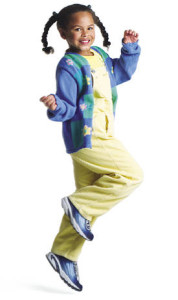Many of us grew up with the “Presidential Fitness Test” that was designed by President Kennedy to create a higher standard of fitness for American youth. These tests assessed the product of a physically active youth culture that was further refined through frequent physical education classes.
Things are different now.
Currently, our youth have demonstrated a significant decrease in play and movement based leisure time activity. Furthermore, only about 4% of America’s schools have daily PE.
The lack of movement and movement education has left our kids with a physical fitness detriment. Scores on these traditional tests have been on a significant decline over the last 15 years.
The progressively abysmal data from these tests only magnifies the problem; it does little to provide a solution. WHY do our kids have terrible strength to weight ratios? WHY do our kids have concerning BMI’s? WHY do our kids continue to demonstrate decreases in aerobic based testing?
It’s impossible to completely address the solution without looking at nutrition, so let’s agree to have that conversation at another time.
Let’s talk movement.
The answers to the physical disparages highlighted above all hinge on the fact that kids don’t develop the foundational strength, stability, mobility, coordination, and balance needed for physical literacy while they are spending hours a day watching television, or playing video games.
These foundations have always been developed while kids crawled, climbed, rolled, and chased their way through early childhood. Mastery in these movements creates a stage for higher level fitness and physical performance. Without these foundations, a performance ceiling can occur, even with athletic children.
 A more appropriate intervention to assessment and programming would be to assess these foundations in youth. CAN they crawl? CAN they skip? CAN they balance? Do they have the mobility and strength for basic human movement patterns like squatting and hip-hinging?
A more appropriate intervention to assessment and programming would be to assess these foundations in youth. CAN they crawl? CAN they skip? CAN they balance? Do they have the mobility and strength for basic human movement patterns like squatting and hip-hinging?
If the answer is “no” to any of the above, traditional testing will continue to show decreasing scores. However, by observing and addressing detriments in these foundational movements, fitness, coordination, and overall physical literacy can be improved from the ground up!
SPIDERfit has created a simple qualitative movement assessment for youth from kindergarten through twelfth grade. The assessment looks at the foundations of movement and performance and provides a score that can be used either individually or integrated into a class, team, or group average to determine the appropriate programming intervention.
The scoring system is from 1 – 4. A “1” means there is pain, or a complete inability to do the movement that would merit attention from a specialist, or highly differentiated instruction. A “4” is complete mastery. The most valuable data lies within the difference between a “2”, which is an inability to perform the movement accurately or consistently, or a “3” where the movement is accurate, but not mastered.
• 1: requires a health professional or adaptive physical education interventions
• 2: requires daily intervention and regressions
• 3: has proficiency but requires practice
• 4: has mastery and requires progressions
The goal for a teacher, trainer, coach, or therapist would be for kids to achieve “3’s” on foundational movement tests.
This assessment has been performed with about 7500 youth through individuals, PE classes, and teams. Teachers and practitioners have been astounded to discover their kids’ inability to execute the movements once considered “par for the course” for physical activity.
By integrating the appropriate interventions into warm-ups, circuits, and other strategies, drastic improvements have been seen in youth’s ability to move well. Interestingly enough, improvements in movement quality have yielded improved traditional testing scores.
The SPIDERfit qualitative movement assessment will be available to everyone in September 2014. Meanwhile, take note as to how your kids squat, crawl, skip, roll, flex, extend, balance and move, regardless of their sport or activity. Focus on improving these foundations before hammering away at high- level skills.
The result is physically literate children with a movement vocabulary that prepares them for any sport or physical activity they chose to participate in. In this way, we empower them to one day become happy, healthy, pain-free adults.
For more about the SPIDERfit Assessment approach, watch the video below!
Brett Klika CEO and co-founder of SPIDERfit is an international award- winning certified strength and conditioning coach, author, and motivational speaker with over 20 years experience motivating and inspiring youngsters to a life of health, fitness, and performance.
Brett consults with schools, athletic organizations, fitness professionals, and fortune 500 companies around the world.





Connect with SPIDERfit!